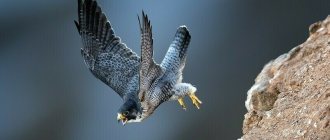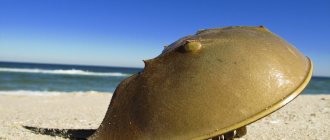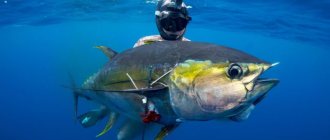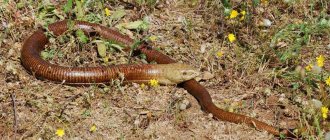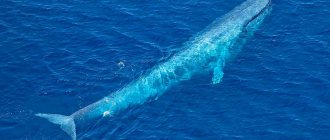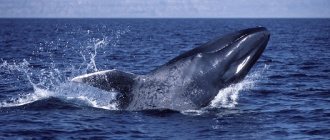The underwater world of the planet's seas and oceans is full of mysteries and secrets that have yet to be solved. This is a separate civilization that exists according to its own special laws and rules. The waters of the oceans are inhabited by billions of living organisms, which differ from each other in structure, form of existence, habits, and way of life. Today we will plunge into the depths of the sea, because TopCafe has come to the attention of the fastest swimming aquatic animals.
Fastest fish in the world:
For the most impatient, let's say right away that the fastest sea creature on planet Earth is the Pacific sailboat, capable of reaching speeds of up to 110 km/h.
10
Pilot whales / Globicephala. 32 km/h
Because of the characteristic shape of their heads, these funny creatures are also called ball-headed dolphins, although their habits, lifestyle and behavior are very similar to whales.
Adults take up to 20 years to grow and can grow up to 8 meters in length. There were pilot whales whose weight reached 3 tons. Despite their enormous size compared to their dolphin relatives, these creatures reach speeds of up to 32 km/h.
In addition, they are excellent divers, capable of diving 600 meters into the depths of the ocean. They live in the northern latitudes of the Atlantic and in the waters of the Southern Ocean.
9
The most poisonous sea creatures
Many sea creatures use poison as a means of attack or defense. The most poisonous creatures that can be found in the waters of the seas and oceans are the box jellyfish Chironex fleckeri. They live off the northern coast of the Australian continent and near numerous islands of Indonesia.
The body of these largest box jellyfish consists of:
- a transparent pale blue dome, approximately the size of a basketball;
- 60 long and thin tentacles, collected in 4 bundles.
Sea wasps, as these jellyfish are also called, are known to have a very strong neurotoxic poison. It is found in the stinging cells that cover the surface of the tentacles. Venom is used by jellyfish to immobilize and kill a victim or enemy. It is also dangerous for humans: it causes severe burns on the skin and affects the central nervous system and heart. The venom of one Chironex fleckeri jellyfish is enough to kill 60 people in just 3 minutes, so there is no need to approach sea wasps unless absolutely necessary.
Barracuda/Sphyraena. 45 km/h
Modern science knows 28 species of the monotypic family of barracudas, and they live in tropical and subtropical waters, as well as in warm seas off the coast of Europe and Asia.
Almost all species of these amazing fish are distinguished by aggressive behavior. History has even recorded facts of barracuda attacks on humans. Barracudas develop high speed, allowing them to hunt small fish.
In its mouth there are several rows of sharp teeth, with the help of which the fish easily copes with prey. Small barracudas prefer to hunt in packs, but large ones are solitary hunters.
8
Spine-tailed Swift
The needle-tailed swift takes an honorable third place in the ranking of the fastest animals in the world; its flight speed can reach 170 km/h. The wingspan of these birds is approximately 55 cm, body length varies from 19 to 22 cm, and weight - from 100 to 175 g. The body and wings are grayish-brown in color, and there are white spots on the throat, forehead and lower part of the tail. Its tail is not forked, like other swifts, but pointed, which is why it got its name.
Needle-tailed swifts are migratory birds; in the warm season they live in Central Asia, as well as in the southern part of Siberia and the Far East, and winter in India, Australia and East Asia. They prefer to settle in forests and groves; they can also be found near ponds, meadows and other open spaces. These birds spend most of their time in flight, hunting for small insects. Nests are made in tree hollows; the depth of the hollow can reach several meters.
Killer whale / Orcinus orca. 55 km/h
This amazing large marine mammal can be found in all parts of the world's oceans. These are the largest representatives of the dolphin family and the only predatory creatures in the whale community.
They received their specific name back in the period of Antiquity, when the ancient Greeks used the word “orca” to name a dangerous sea creature. Then, already in the 19th century, English sailors began to call killer whales “killer whales.”
Killer whales do not consider humans as prey, but other sea creatures should be wary of these fast mammals. But their favorite delicacy is ocean herring.
7
Atlantic tarpon / Megalops atlanticus. 56 km/h
The Atlantic inhabitant grows up to 250 cm in length, and the entire body of the fast-swimming fish is covered with large scales. They belong to the genus of tarpon, which were identified as a separate species in 1923.
It feeds on plankton, small fish and all kinds of insects falling on the surface of the water. Crab and shrimp are important in their diet.
Its appearance resembles herring, but tarpon are larger. Atlantic tarpon are not commercially fished, but some fishermen enjoy catching them on their fishing rods. The meat is tender and tasty.
6
The smartest sea creatures
The most intelligent sea creatures are undoubtedly dolphins. These cute mammals, members of the cetacean order, are distinguished by high intelligence, which allows them to create and maintain social bonds similar to humans. They hunt together, play, raise their own and other people’s cubs, teach their relatives, and help them in difficult situations.
It has been established that dolphins have very developed communication:
- they actively and happily communicate with each other;
- establish new connections;
- give each other unique names.
Moreover, they are able to distinguish not only sounds, but also to form “words” and even entire “sentences”. Some scientists suggest that dolphins even have their own dialects.
Dolphins also love to communicate with people, they learn easily and quickly and are happy to carry out learned commands and play with small children. There are cases when these animals came to the aid of drowning people, supporting them in the water and pushing them to the shore.
Atlantic bonito / Sarda sarda. 64 km/h
Silvery fish with dark stripes on the back and sides are also called bonito or sarda. Pelamids are found off the coast of Africa, Europe, Central America, and sometimes swim into the waters of the Mediterranean and the Black Sea.
This is a marine predator whose diet includes species of small fish, invertebrates and crustaceans. Scientists have also noted the cannibalism of bonito.
During hunting, these fish develop high speed. They are widely used in cooking. This fish makes excellent dishes that are full of useful minerals.
Albuka / Albula vulpes. 64 km/h
This beautiful fish, which is found in the warm waters of tropical and subtropical seas, prefers to stay in shallow coastal waters.
Developing speeds of up to 64 km/h, albuca is considered the fastest shallow-water fish in the world's oceans.
This is an important fishery. Fish is actively caught for its tasty meat. But it is worth noting that the fish is very bony. Active fishing led to a sharp decline in the population at the end of the twentieth century. For this reason, this species of the albuceae family was given protected status.
4
The smallest sea creatures
The smallest fish that live in the seas are several species of dwarf gobies, outwardly very different from each other in a number of characteristics. But what they have in common is that they are very small in size - their body length does not exceed 5 cm.
All dwarf gobies:
- live in bottom waters near coral reefs;
- lead a sedentary lifestyle;
- almost never leave their habitat.
Many of them do not have a swim bladder, which prevents them from moving quickly. They feed on plankton and tiny crustaceans passing by.
Dwarf gobies breed in the same place where they live - on the bottom near coral reefs. They glue the eggs to the stones and protect them until the fry hatch. But parents do not take part in the future fate of their offspring.
Interestingly, dwarf gobies are able to change sex if necessary. Moreover, just as males can become females, so females can become males.
Yellowfin tuna / Thunnus albacares. 74 km/h
One of the most commercial fish in the world's oceans, also called ahi tuna. A social fish that likes to stay in schools and easily communicates with other ocean inhabitants.
The photo shows yellowish fins and a yellow stripe, which is why the fish got its species name. The belly is silver, but the back of the tuna is grayish-blue. These tunas are omnivores. The special structure of the body and strong fins allow it to develop great speed, even overcome strong ocean currents.
3
Mako shark / Surus oxyrinchus. 75 km/h
The dangerous predator is found in temperate and subtropical waters of the world's oceans. Its enormous speed allows the mako shark to overtake almost any prey.
Adults grow to an average of 3 meters 30 centimeters, although makos measuring 4.45 meters have been caught in history. Despite its large size, it is the most agile and dexterous of all sharks. It develops great speed and can also emerge from the water to a height of up to 6 meters.
These sharks are dangerous to humans, and most importantly, they attack not only people in the water, but also boats. Cases have been recorded of these predators attacking submarines.
2
Swordfish / Xiphias gladius. 97 km/h
This unique representative of the unusual family of swordtails has chosen the waters of all the oceans of the planet as its habitat, easily migrating in search of food.
The object of active fishing in more than 30 countries of the world, but most of all, swordfish is a magnificent trophy of sport fishing. But due to caution and high speed abilities, catching her is not so easy.
Swordfish have virtually no natural enemies. The only marine life they can prey on are mako sharks and killer whales. These unusual fish are also plagued by parasites that settle on their bodies. By the way, topcafe has very interesting material about how some animals have learned to resist parasites.
1
The most terrible sea creatures
In this category of marine life, the first place is undoubtedly occupied by angler fish, which live almost at the very bottom of the Atlantic, Indian and Pacific oceans. At such a depth, beauty is not needed, the main task is to survive, so angler fish adapt as best they can.
For this they have:
- a shapeless and often ugly body, which, however, can withstand strong water pressure;
- a huge, non-closing mouth with long and needle-sharp teeth;
- illicium (fishing rod) - a thin and long ray of the dorsal fin with a small glowing skin outgrowth at the end, acting as a bait.
A fishing rod hanging over the anglers' heads works in this way: the light emitted by it attracts prey, which itself swims up to the predators and they can only swallow it. This organ varies in size and functionality among different species of anglerfish: some fish can regulate the intensity of the glow and even the length of the fishing rod itself, bringing the prey directly into its mouth.
Anglerfish also reproduce in an unusual way: males find females, attach themselves to them with their teeth, and remain hanging on them. This saves both of them from having to look for a new partner every time.
Swallowtail / Istiophorus platypterus. 110 km/h
The fastest fish in the world easily reaches speeds of up to 110 km/h, which was proven by tests in the state of Florida. Let's compare that the fastest land animal, the cheetah, can run at a speed of 100 km/h.
It can hide part of its fins in its body, which gives sailboats an aerodynamic shape and allows them to reach such record speeds. Excellent speed is also achieved through water turbulence that occurs around the fish’s body.
Sailfish are dangerous predators, and such speed allows them to overtake any prey. They grow up to 3.5 meters in length, and the maximum recorded weight was 107 kg.
Peregrine Falcon
The peregrine falcon is the champion in the ranking of the fastest animals. The maximum measured flight speed of this bird is 389 km/h! Not a single animal on the planet can outrun the peregrine falcon. This bird of prey develops its greatest speed during a diving flight, which it makes while hunting, first flying up and then rapidly rushing down.
The peregrine falcon belongs to the falcon family and lives on all continents except Antarctica. The wingspan is from 80 to 120 cm, and the body length is from 35 to 50 cm. Females are much larger than males, their weight can reach 1.5 kg, and the maximum weight of males does not exceed 750 g. Peregrine falcons hunt mainly small birds, but They can also attack small mammals.
Peregrine falcons have long been used by humans for falconry, as they are easily tamed, have extraordinary hunting abilities and are well bred in captivity. It is known that they were caught and domesticated more than 3000 years ago. Nowadays, peregrine falcons are sometimes used to scare away birds at airports.

